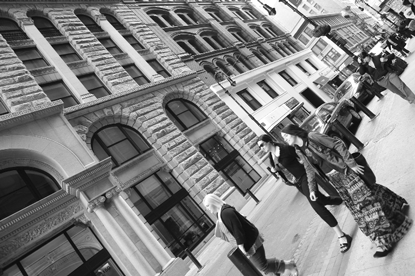By Ronda Kaysen
A swath of the Financial District may soon become an historic district, a change that would be largely honorific in nature, but provide potentially lucrative tax incentives for some property owners in the district.
The State Historic Preservation Office has taken a special interest in the Fulton-Nassau area and hopes to place a slice of Downtown north of Liberty St. and south of Spruce St. on the state register of historic places. Once the district lands on the state register, the application will then be forwarded to Washington D.C. so it can secure its place on the national register.
“This is probably the most important historic proposal we’ve got on the docket this year,” said Mark Peckham, national register unit coordinator, at a May 2 public hearing. “We’d certainly like to see it go forward.”
Behind the garish awnings flaunting cheap shoes and Prada knock-offs along the blocks east of Broadway, Theatre Alley and Park Row and west of Nassau, Dutch and William Sts., is an abundance of buildings seeped in city history. Many of the buildings date back to the 1860s through the 1930s, reminiscent of the neighborhood’s long commercial history.
“We said, ‘Wow, this is really intact, this is really amazing,’” Simeon Bankoff, executive director of the Historic Districts Council, said in a telephone interview of his first serious consideration of the neighborhood in early 2001. “You have these riotous signs on the storefront, but underneath everything’s intact. You’re blown away by the intactness of it.”
H.D.C. proposed the idea to SHiPO in March 2003, in the hopes it might revitalize the tawdry area, which has been unduly burdened by the World Trade Center disaster. “All of a sudden all the stores were shuttered after 9/11,” Bankoff said. “We thought this is a real opportunity to bring these buildings back.”
Unlike city landmark preservation laws, which carry strict construction guidelines, a position on the national register places few restrictions on property owners. Developers are free to alter – or even demolish – any properties in the district and buy and sell property as they see fit.
SHiPO only steps in and makes recommendations, which could impact a development when a property owner taps state or federal funds for a project — such as Liberty Bonds and Community Development Block Grant funds.
And then there are the perks. Commercial or rental property owners are eligible for a preservation tax credit, which allows a 20 percent credit for substantial renovations, and non-profit organizations are eligible for historic preservation grants. There are no tax incentives for residential property owners, however.
“It’s largely honorific, but there’s a little icing on the cake,” said Kathleen Howe, a historic preservation specialist for SHiPO, referring to the tax incentives.
The handful of property owners, Community Board 1 members and other residents who attended the public hearing responded enthusiastically to the proposal. “I’m so happy that this project is going forward and I really hope it goes through,” said Nina Lavin, a Tribeca resident.
Bruce Ehrmann, chairperson of C.B. 1’s Landmarks Committee, suggested writing a resolution in support of the plan.
The proposal has not always received such a warm welcome. When SHiPO and H.D.C. first fielded the idea to C.B. 1 in Sept. 2003, it was met with marked resistance and skepticism.
“All the plans were in flux back then,” C.B. 1 member Roger Byrom told Downtown Express after the meeting, referring to the massive redevelopment changes facing the neighborhood in the months after 9/11. Board members worried, “Is this going to complicate things?”
Since the 2003 presentation, the neighborhood has changed its tune, as was evident at Tuesday night’s meeting. “There’s a lot of support from the people in this room,” said Byrom.
SHiPO sent letters to property owners in the historic district two weeks ago and has received few calls regarding the proposal.
The handful of residents who have called H.D.C.’s offices inquiring about the proposal, said Bankoff, are mainly property owners curious about the tax incentives.
With the community’s blessing, the proposal will appear before the state review board on June 15 and potentially join the 80,000 other New York State properties on the national register by the fall.
WWW Downtown Express


















